A turbulent October shows the other side of autumn
Sunday, November 9, 2014
Welcome at last to our October News. Please accept my sincere
apologies for the late posting of the news but we lost Broadband
connection for 7 days at the end of the month
As we move deeper into autumn parts the garden, as to be
expected, are beginning to look a little ragged at the edges. Some
plants have finished and others are just hanging on. but on 28
October I counted 243 plants still in bloom many also showing new
buds The autumn colour is incredibly good and there are other
treasures doing their stuff too. The priority tasks have moved away
from watering, deadheading and general titivating to taking
cuttings and diviisions, removing congested clumps of hardy
perennials and harvesting vegetables for storage.
The view across the Paddock Garden with from left
to right cercis canadensis, cornus kousa var.chinensis and cornus
controversa showing good autumn colour
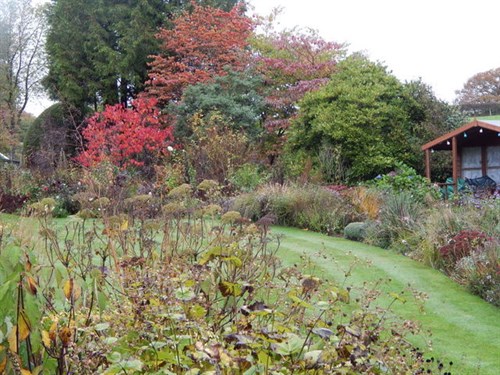
Two weeks on and cercis canadensis "Forest Pansy" is a
brilliant deep red just a few days before a gale brought the show
to an abrupt end

Cutting back the gunnera which was huge this year is
always a task to complete before the frosts arrive. All the leaves
are used to cover the tender crowns of the plant. Some of the leaf
stems, covered in sharp spines, are 2 inches thick but easily
sliced through with a pruning saw.
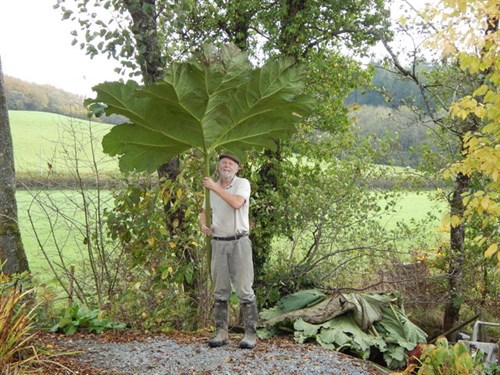
Getting in the firewood is an essential task with some
lovely air dried oak from the woods above Trefenty, thanks to our
good farmer neighbour Ifor.

And from the woods is this great view looking south to
the Lodge in the bottom of the valley at 250 feet and the
protecting hill beyond at 650feet
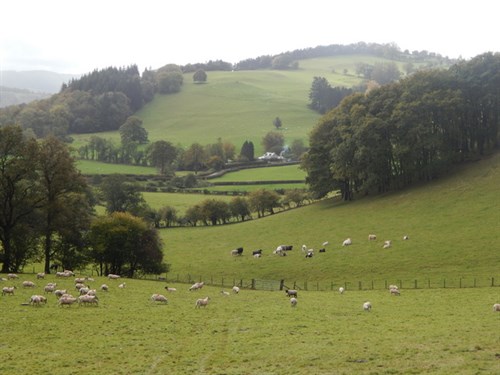
It is also the time to start major repairs and refurbishment all
over the gardens, with a long list to keep me busy during the rest
of autumn and into winter. It is nice to have some different jobs
to do away from gardening. Much as love all aspects of gardening
from January to October by this time of year I am ready for a
change. I do hate it however when the clocks go back and Christmas
starts to creep everywhere. Don't you?
Weather
A very mixed bag of weather with frequent rain and wind, thunder
and lightning in the first part of the month but some very mild
days and nights and no threat of frost. A fabulous full moon
and clear weather to enjoy it. We missed out on the " Super Moon"
last month but this month's almost made up for it. Min 4.1
Max 18.7C
I typed this on 29 October before our broadband went down. Then
on the last day of the month we had a daytime max of 21C with an
overnight min of 15.6 to complete a warm week when shirt sleeves
were the order of the day. More weather records broken!
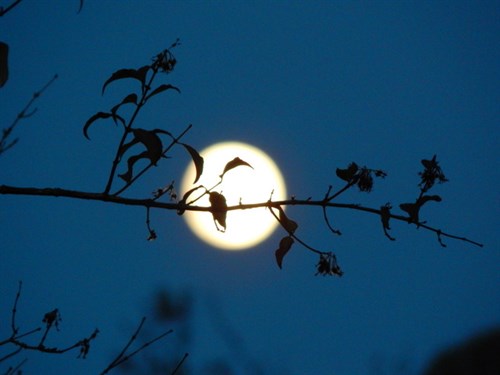
Garden Update
Hanging baskets under the verandah, a feature here every year
from 1977 onwards, took a battering earlier in the month and
had to be talken down by mid month. I do miss them but the house is
much lighter and there is less daily work for me to do. It
also gave the opportunity to complete the log pile under the
verandah which will supply most of our winter needs. I know that
from 1913 onwards everyone who has lived at the Lodge has created a
similar log store - goodness knows how many tons of wood have been
burned in that time. A good mix this year of oak, ash, willow,
pine, alder and some beech and sycamore all gathered and cut up by
me.
The vegetable garden continues to be productive from fresh and
in store. Swedes and parsnips are now ready and there are still a
good range of salad leaves including some well blanched endive
which adds a slighter bitter but welcome tang to a mixed
salad. The outdoor ridge cucumbers have been the best ever but are
now coming to an end. Smaller but sweeter than hothouse varieties
they are easier too but are rarely every straight like the climbing
kind.
The outdoor cucumbers variety "Burpees" towards
the end but still a few fruits left to harvest. We have been self
sufficient in them for 4 months.

Tomatoes continue to ripen well with plenty more still
to come although the fruit on mini plum "Rosada" begins to split as
soon as it iripens. "Rosada" on the left of the basket, "Gourmet"
on the right.

The overworked basket with shelled berlotti beans - a
"favourite" job of Moira's! Not only good to look at but a
wonderful addition to casseroles and salad.

There are some unsung heroes at this time of year that may not
be stars in their own right but considerably add to the enjoyment
of October. Here are some of the best of them
Saxifraga fortunei "Rubrifolia" which prefers shade and
moisture and looks good with evergreen leaves of plants such
a heuchera "Frosted Violet Dream", also in the saxifraga
family.
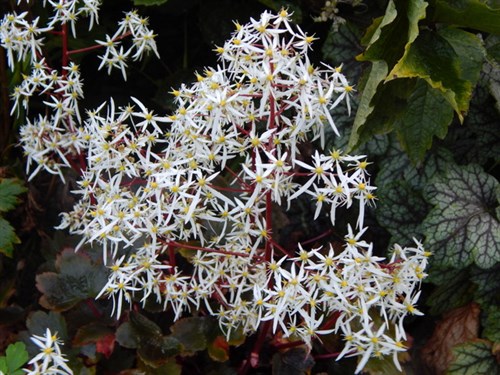
At first glance you could mistake the plants in this pic
as an aster, but they are another member of the daisy family,
kalimeris (cultivar name unknown) Commonly called the "Korean
aster" they have been in full flower since late July never seeming
to have any spent flowers or requiring deadheading. Making a dome
of about 80cms they are quite a statement even though they are not
show stoppers. It is easy to take them for granted but for their
reliabilty, long flowering period they are certainly an unsung hero
long after the prima donnas have given up the ghost.
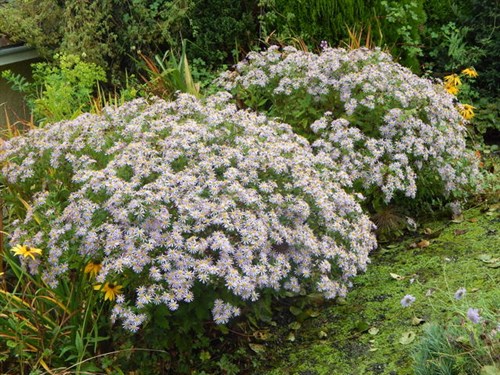
This one is however a showstopper when in flower, A
bromeliad, fascicularia bicolour can be hardy if you have a very
sheltered spot in well drained soil. Planted on its side to prevent
water gathering in the crown it is said to be hardy to -10C but in
our frost pocket garden it stays in a large plot and overwinters in
a tunnel. At Picton Castle they grow like weeds
outdoors.

Sorbus commixta "Olymic Flame" a good tight upright form
has wonderful autumn colour quite early on, red berries and good
panicles of white flowers in spring
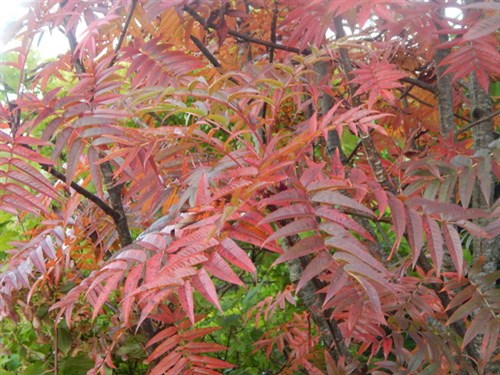
A really late flowering daisy is bidens heterophylla
"Hannay's Lemon Drop". It runs a bit especially in the moist spot I
have it in, but has a lovely airy habit and flowers in
profusion to 5 feet
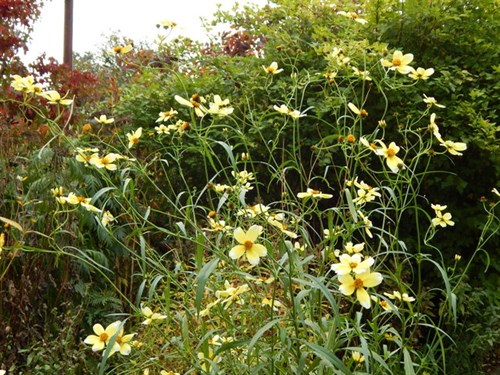
Even when the flowers fade some plans like this
rudbeckia var. sulliantii "Gold Sturm" have lovely seed heads,
these bosses of black make quite a statement sometimes until
December. One of the reasons why I don't cut back herbaceous
plants until late winter
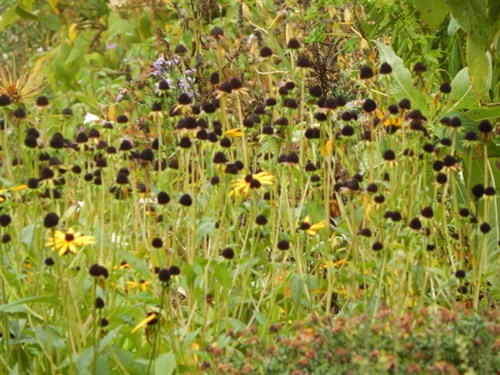
The fully ripe seed pod of arisaema ciliatum liubaense
ready to be harvested, cleaned of all the flesh, dried and sown
next spring. Leave them any longer and blackbirds and rodents will
devour the berries overnight.
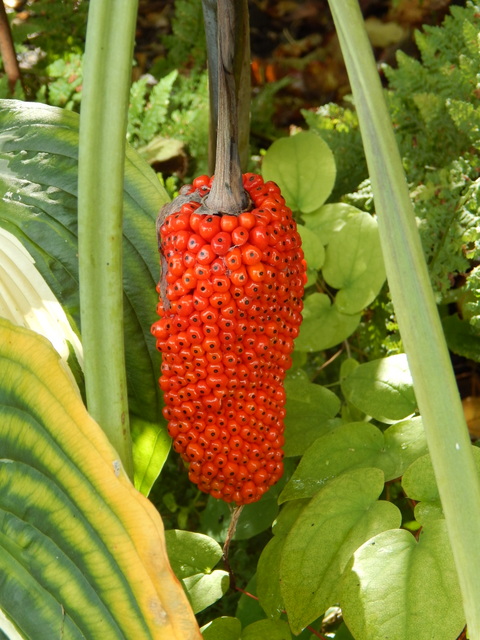
The nursery area needs to be cut back and all plants put under
cover - cold frames, tunnels or green houses. The key to getting
plants in pots through the winter is to keep them on the dry side
and over the course of the last 8 years or so I have had very
few losses whatever the winter has thrown at us. All autumn
cuttings and divisions as well as more tender plants and large
planters, have the luxury of heated polytunnel protection.
Considering all the rain we have had and warm weather the lawns,
particular;y in the House Garden, have not come back well from the
major scarifying and top dressing they had at the end of August and
there are still some bare patches despite sowing grass seed twice!
They will come back even if I have to sow again next spring!! I am
still mowing which also takes care of the many leaves
beginning to fall on them.
Finallly I have just finished drying and cleaning 46 varieties
of seed from the garden for my own use, to donate to the Hardy
Plant Society for their fabulous Seed Exchange for members or to
share with clubs and societies when I deliver talks.
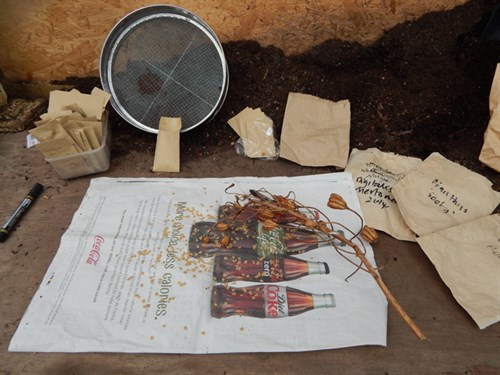
What's looking good.
Simply salvias, brugmansias, roses, superb leaf colour and
impatiens. There is also an amazing coulour show in the greenhouses
and tunnels and the dahlias are still sending out masses of flowers
too
A gallery of some of the very best
Brugmansia suaveolens in pot outside the
conservatory. Feeding with liquid fertilser high in potash ensures
continous flowering and a warm summer helps too!

Salvia splendens "Van Houttei"

Salvia leucanthe "Santa Barbara"
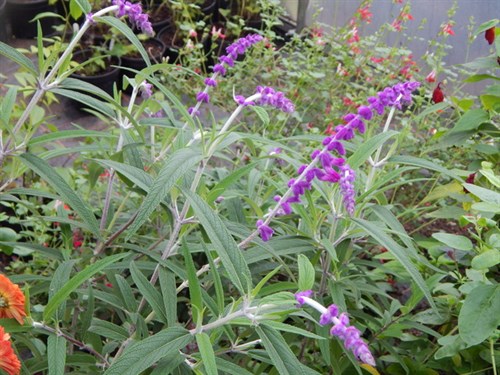
Salvia "Phyllis Fancy"
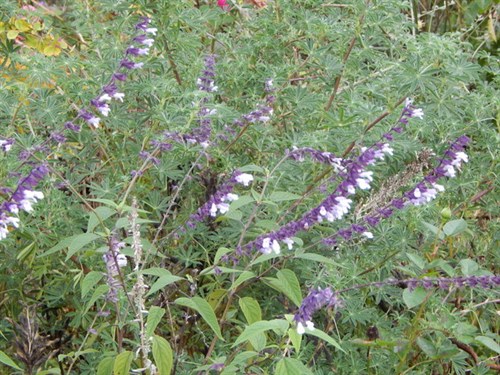
Salvia "Amistad"
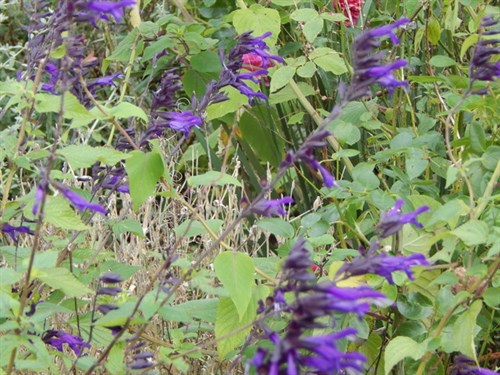
All the salvias above make about 4-5 feet and are
tender.
Dahlia merckii in a paler form than the type is a
profuse flowerer from early July until the frosts
and is still going strong. It has proved very hardy for me over
many years and is now a large plant 6' wide and tall.
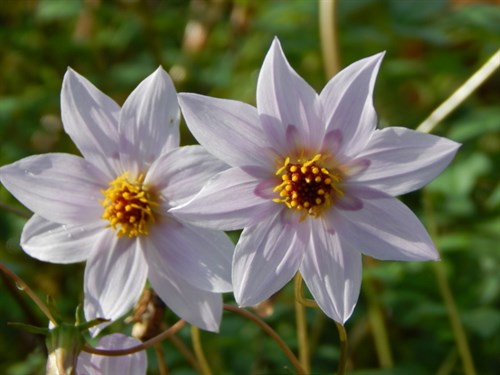
An unusual form of dahlia this is Honka yellow. Not
everyone's idea of a dahlia perhaps but interesting and a valuable
late flowerer with less petals to spoil in wet weather
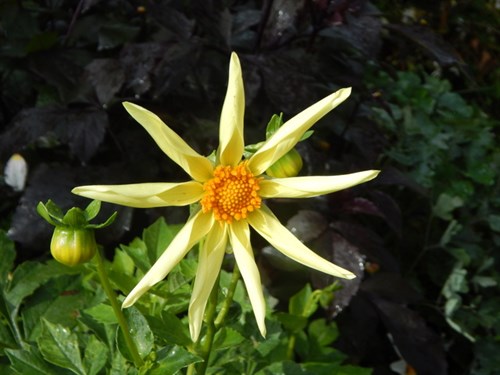
Now (and at last!!) on to touch -me-nots, balsams or bizzie
lizzies. A fascinating and highly varied genus with over 1,000
species and some cultivars. Mostly known to gardeners through
impatiens walleriana (the bedding bizzie lizzie), and the larger
New Guinea hybrids. Also through Himalayan balsam (impatiens
glandulifera) which has become naturalised in many parts of the UK
in moist positions along streams and rivers and shady road verges
to the extent that it is now considered a noxious weed.
There are some far less invasive forms both perennials and
annuals that are hardy and can be safely grown in the garden in a
moist sheltered spot. Very few of the 1000 or so species are
available to gardeners in the UK (the 2014 Plant Finder lists only
60) and many of those are tender. In total we currently grow 15 at
Cilgwyn Lodge and they have done very well over a number of years.
Given that the traditional "bizzie lizzie" has succumbed badly to
downy mildew over the past few years, why not try some of those
listed below representing a selection of those that we grow, and
which so far seem immune to the disease. They all flower almost
continuously throughout the summer until the frosts.
Oh and by the way I have should have mentioned that the name
"touch me nots" comes from the explosive seed pods which when ripe
and gently touched at the base fire the seeds in all directions -
and if you try this mind your eyes!
Impatiens glandulifera - Himalayan balsam, fortunately
not at Cilgwyn Lodge, much as I like the flowers
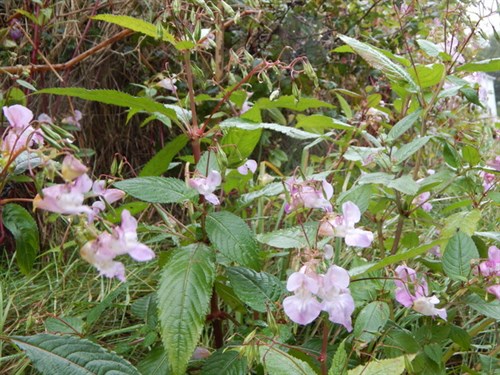
I have a very soft spot for I. tinctoria which was the
first I acquired, a tuberous, sweetly scented form to 7 feet, from
the mountains of eastern Africa but established at Colgwyn for 15
years
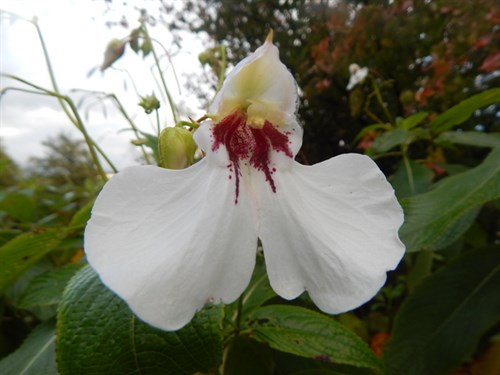
Recently discovered by Dan Hinkley in the far east is
this variant of I. omieana, without a regiseterd name at present.
Large flowers and deep green leaves with red midribs and stems. Set
to become a stunning addition to my collection
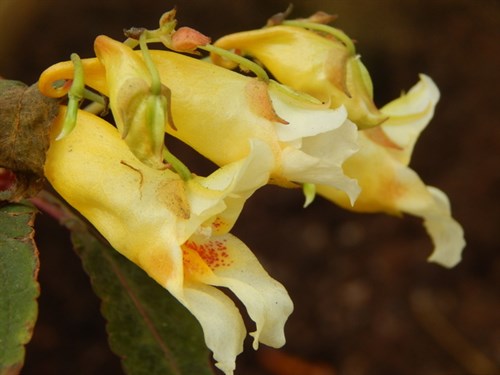
A clump forming species with masses of yellow flowers
and dark green, bluish leaves - dainty and attractive and at just 2
feet tall a suitable choice for the front of a border

One of the tender forms is I. sodenii a tall
tuberous rooted with large outward facing flowers up to 2 inches
wide
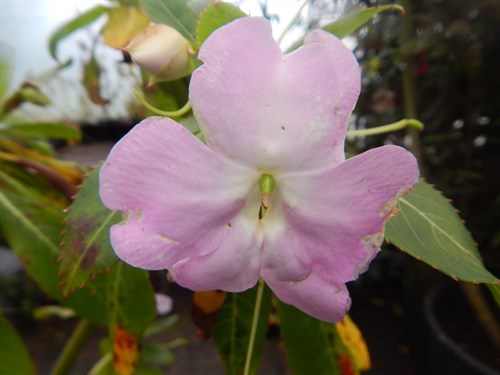
And surely the best named form is I. niamniamensis
variegata the golden cockatoo from central Africa so
definitely tender.

The only known blue form is I. namchabarwensis found in
the Himalayas in the deepest gorge in the world. It behaves like an
annual in the garden and in my experience does not set seed. Grow
some in a tunnel however and during the late winter the seeds come
up like mustard and cress in surrounding pots for pricking out to
flower later in the year.
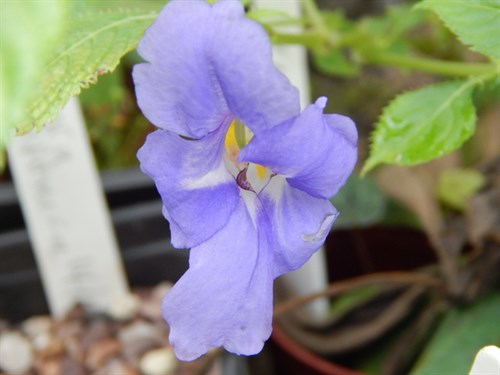
Passiflora rubra in the small tunnel. It now covers the
upper framework to a distance of 20 feet.
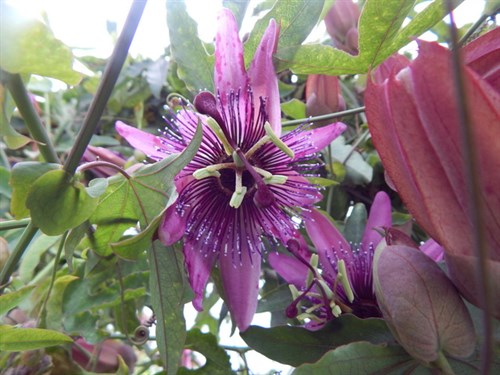
Nerine sarniensis in the large tunnel
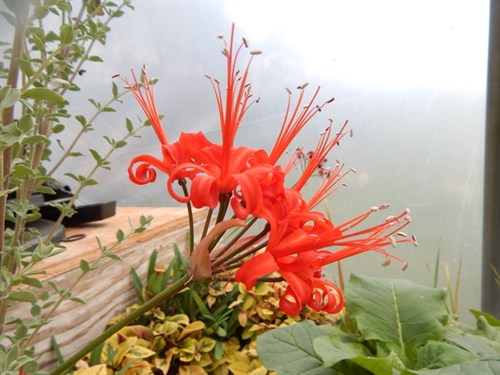
A collection of streptocarpus, begonias,
pelargoniums, fuchsias and other tender plants - over 100 plants in
an 8 x 6 feet greenhouse

Although there aren't too many herbaceous that have good
autumn leaf colour some hostas and hardy geraniums, amsonias,
roscoeas and thalictrums often colour up well,
Roscoea "Red Gurkha"
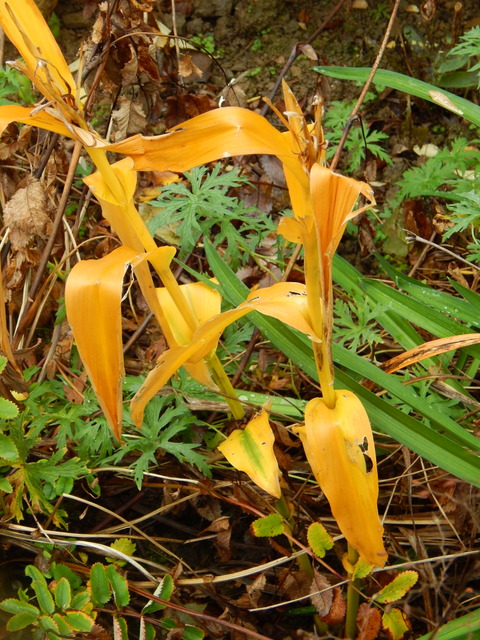
Thalictrum "Splendide"
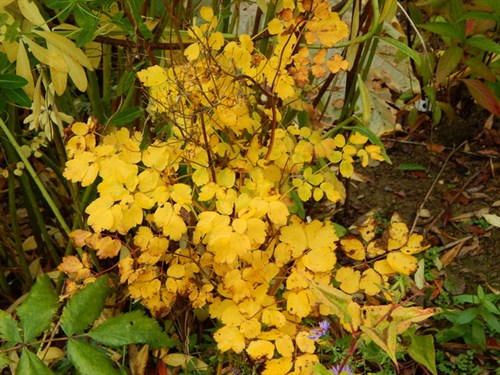
Rosa "Gentle Hermione" from David Austin is a
beautiful flower but on a rather arching plant which holds the
flowers down. Modest scent but good repeat.

Wildlife and Countryside
Having seen what we thought were the last of the swallows in
early October, there was another good showing on a fine day in the
second week of the month with perhaps well over a hundred birds on
the wires and swooping over the fields (not sure of the numbers but
have you ever tried to count swallows ?) Just as quickly as they
arrived they were off again on their long journey south.
Some wonderful berries in the hedgerows from spindle (euonymus)
, guelder rose (viburums), sloes, wild roses and hawthorn. With the
mild autumn they have been largely untouched but they won't be here
long when the cold weather comes and the fieldfares and redwings
arrive form colder areas of northern Europe.
Remaining blackberries shrivelled on the bush - it was a
very good year for them

When visiting West Wales earlier in the month I was struck by
just how common the Welsh native fern polypodium cambricum is in
shaded banks, hedgerows and woodland. Many unusual forms have been
discovered in the past by avid fern collectors (particularly
Victorians) and there is now a good choice available for suitable
spots in the garden. It is unusual type of fern because it comes
into growth often as late as July but then continues all through
autumn and winter staying evergreen in milder winters. It is
generally easy to please and I am starting to acquire a modest
collection. Knowing me it won't be modest for very long!
Polypodium cambricum in woodland
appreciating the moist air near Cenarth Falls

And at Cilgwyn a named form probably wild
collected, polypodium "Conwy"
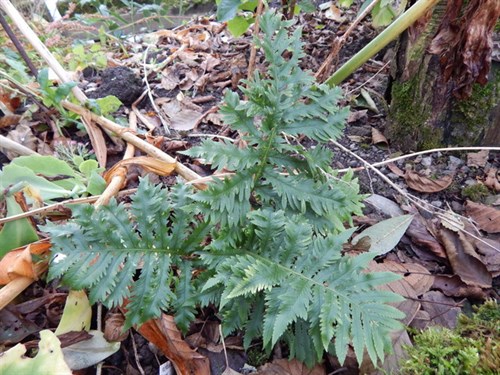
Whilst gathering firewood from Trefynty I went past a field of
cows and a large Charolais Bull. It brought back to mind an event
some years ago when I tried to prevent a bull on the loose in the
road, from coming into the drive. He wasn't having any of it as he
had thoughts on getting into an adjacent field of rather pretty
hefeirs. At a steady trot he came after me and believe me if you
have ever been that close to a bull you will know how big they are.
From somewher in the long distant past I found a turn of speed that
saw me placed a respecatble 3rd in the under 14's 100 yards at my
grammar school, to out pace him and fly through a field gate to
safety. I was closely followed by my neighbour Ifor armed with the
stockman's best friend in these situations, a fine length of stout
alkathene pipe. Fearless he "gently" persuaded the bull to change
direction and got him back safely. Ifor says never take a chance
with a bull and believe me I have no intention of doing so ever
again!!

Visits
With friends Sylvia and Tony staying for a few days after
the last Plant Fair of the year at Hergest Croft, Kington,
Herefordshire we took the opportunity in fine weather to go back to
West Wales to Poppit Sands (again)which has left quite an
impression on Moira and me.
Evening sunlight on the beach at Poppit
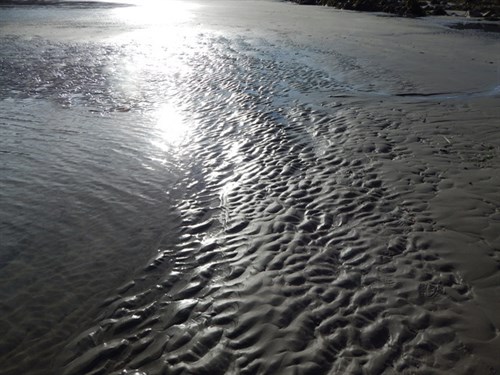
On the way home we stopped off at Cenarth Falls on the River
Teifi. We have pictures from 1973 when Tony, Sylvia and I last
visited and it is so reassuring that we don't seem to look any
older!! I can't show you the pictures of course as they are
pre-digital age so you will just have to take my word for it!! The
Falls still look as beautiful too.
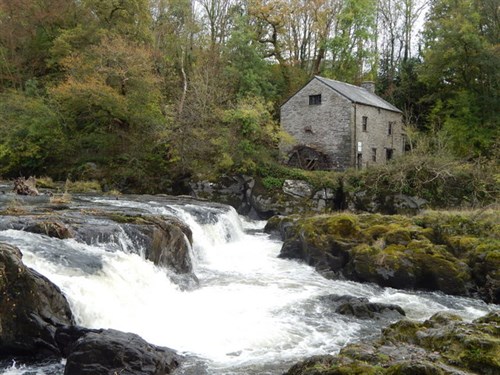
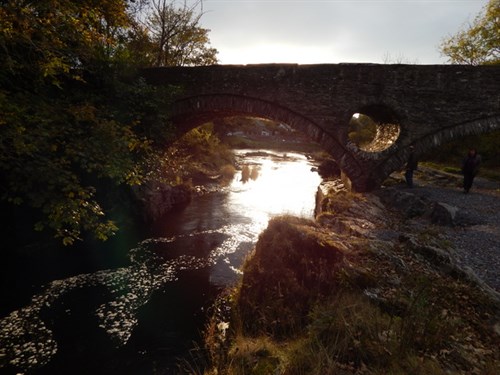
Our second outing was to the Llanelli Wetlands Centre which if
you have the time is an all day venue with walks far out to the
estuary of the River Loughour and interest nearer the centre with a
collection of wildfowl from all over the world in a very
naturalistic setting
Flamingoes venturing out of their warm shed - a
somewhat bizarre but warming scene on a raw Welsh
afternoon
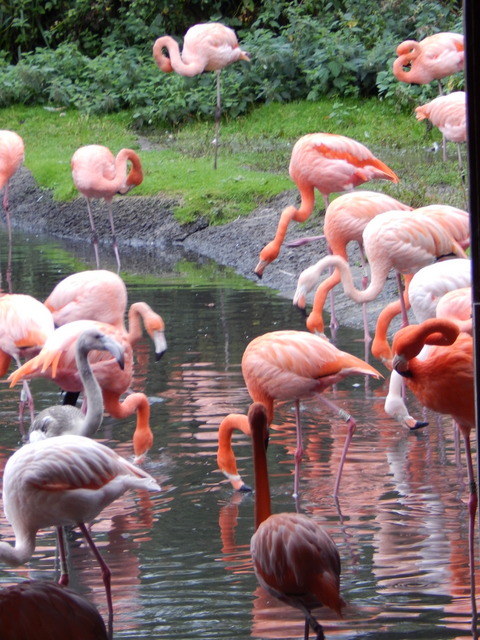
And of all the many attractive ducks from around the
world the eider for me has star billing - such perfection of line
and colour it doesn't look real.
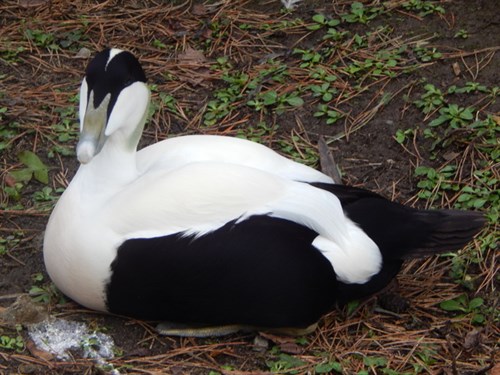
Just one talk in October with thanks to Bronwydd Garden Club for
their warm welcome and good attendance. Hope to see you all again
when you visit the gardens in 2015.
And finally, totally appropriate for the last day of October,
Moira and I judged the Halloween pumpkins and fancy drees
competition at Llangadog Community Centre. We never realised how
many children there are in our localiity and they had a wonderful
time in an amazing range of costumes from fairy princesses to
zombies! Their pumpkin carving was very good too.
Thanks for staying on until the end of this mammoth News Item .
I assure your for the next few months they wiill be substantially
shorter!
